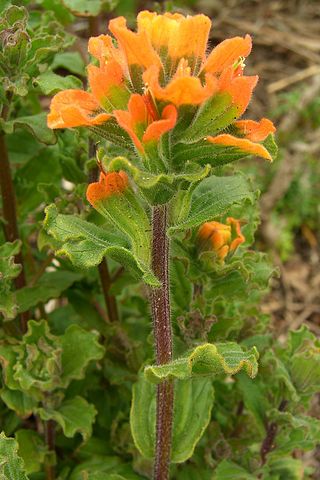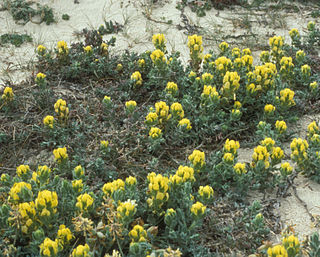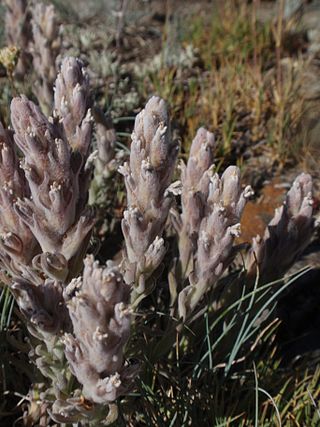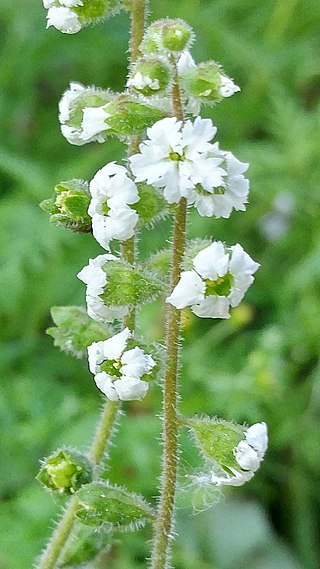
The Tiburon paintbrush or Tiburon Indian paintbrush is an endangered taxon of flowering plant in the family Orobanchaceae. It is endemic to the San Francisco Bay Area in California in the United States, where it occurs in Marin, Napa, and Santa Clara Counties.

Castilleja angustifolia is a species of wildflower known by the common names northwestern Indian paintbrush and desert Indian paintbrush. It is an herbaceous perennial native to the desert, scrublands, and woodlands of western North America. It grows in hot sandy soils and rock crevices in dry conditions.

Castilleja campestris is a species of Indian paintbrush known by the common name vernal pool Indian paintbrush. It is native to California and southern Oregon, where it grows in seasonally moist habitat, especially vernal pools.

Castilleja cinerea is a species of Indian paintbrush known by the common name ashgray Indian paintbrush. It is endemic to San Bernardino County, California, where it is known only from the San Bernardino Mountains. There are about 20 occurrences known.
Castilleja lasiorhyncha is a species of Indian paintbrush is endemic to southern California known by the common name San Bernardino Mountains Indian paintbrush. Most of the plant's range is in the San Bernardino Mountains, where it grows in forests and meadows.

Castilleja latifolia is a species of Indian paintbrush known by the common name Monterey Indian paintbrush.

Castilleja mendocinensis is a species of Indian paintbrush known by the common name Mendocino Coast Indian paintbrush.

Castilleja miniata is a species of Indian paintbrush known by the common name giant red Indian paintbrush. It is native to western North America from Alaska to Ontario to California to New Mexico, where it grows usually in moist places in a wide variety of habitat types.

Castilleja mollis is a species of Indian paintbrush known by the common name softleaf Indian paintbrush. It is endemic to the Channel Islands of California, where it is currently known only from Santa Rosa Island. An occurrence was once noted on San Miguel Island, but the plant has not been found there since 1938. Its habitat is the coastal sage scrub around the windy sand dunes and bluffs.

Castilleja schizotricha is a species of Indian paintbrush known by the common name splithair Indian paintbrush.

Castilleja subinclusa is a species of Indian paintbrush known by the common names longleaf Indian paintbrush and Franciscan paint brush.

Castilleja pruinosa is a species of Indian paintbrush known by the common name frosted Indian paintbrush. It is native to California and Oregon, where it grows in several types of forested habitat.

Lithophragma maximum, known by the common name San Clemente Island woodland star, is a rare species of flowering plant in the saxifrage family. It is endemic to San Clemente Island, one of the eight Channel Islands of California. It is known from only about four kilometers of rocky coastal cliffs on the edge of the island. The plant was thought to be extinct until a few specimens were rediscovered in 1979. Only 200 individuals were tallied in a 1996 survey. In 1997 the plant was listed as an endangered species on the federal level.

Malacothamnus clementinus is a rare species of flowering plant in the mallow family known by the common name San Clemente Island bushmallow. It is endemic to San Clemente Island, one of the Channel Islands of California, where it is known from fewer than ten occurrences in the steep, rocky seaside canyons.

Castilleja levisecta is a rare species of flowering plant in the family Orobanchaceae known by the common name golden paintbrush, or golden Indian paintbrush, listed under the Endangered Species Act in 1997. It is native to British Columbia and Washington, where it is known from eleven remaining populations. It occurred in Oregon but all natural occurrences there have been extirpated. It has been reintroduced to a few areas in Oregon, but it remains to be seen if the plants will survive. The plant is a federally listed endangered species of Canada and was listed as threatened in the United States in 1997. On June 30, 2021, the plant was proposed for delisting due to recovery.
Sanicula mariversa is a rare species of flowering plant in the family Apiaceae known by the common name Waianae Range black-snakeroot. It is endemic to Hawaii, where it is known only from the Waianae Mountains on the island of Oahu. It is threatened by the degradation of its habitat. It is a federally listed endangered species of the United States.

Castilleja christii is a rare species of flowering plant in the family Orobanchaceae known by the common name Christ's Indian paintbrush. It is endemic to Idaho in the United States, where there is a single population on Mount Harrison in the Albion Mountains in the Minidoka Ranger District of Sawtooth National Forest. It is one of Idaho's rarest plants.
Castilleja aquariensis is a species of flowering plant in the family Orobanchaceae known by the common name Aquarius Plateau Indian paintbrush. It is endemic to Utah in the United States, where it occurs on the Aquarius Plateau, including Boulder Mountain. All occurrences are within the bounds of Dixie National Forest.
Castilleja salsuginosa is a species of flowering plant in the family Orobanchaceae known by the common name Monte Neva Indian paintbrush. It is endemic to Nevada in the United States, where it is known from two populations, one in White Pine County and another in Eureka County. The two occurrences of this plant are located about 83 miles (134 km) apart within the Great Basin. There are only about 275 individuals.
Castilleja kerryana is a species of flowering plant in the family Orobanchaceae. It is commonly known as Kerry's Indian paintbrush or Kerry’spaintbrush. It was formally described in 2013 and so far it is known only from a small population in the state of Montana, in the Northwestern United States.

















